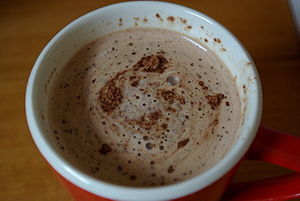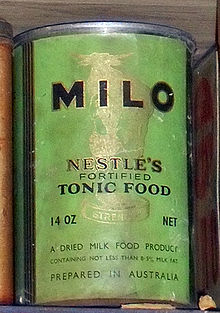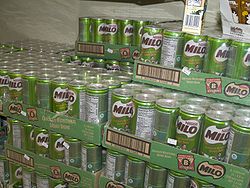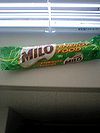- Milo (drink)
-
Milo (
 /ˈmaɪloʊ/)is a chocolate and malt powder which is mixed with hot or cold water and/or milk to produce a beverage which is popular in many parts of the world. Produced by Nestlé, Milo was originally developed by Thomas Mayne in Sydney, Australia in 1934.[1] It is marketed and sold in many countries around the world.
/ˈmaɪloʊ/)is a chocolate and malt powder which is mixed with hot or cold water and/or milk to produce a beverage which is popular in many parts of the world. Produced by Nestlé, Milo was originally developed by Thomas Mayne in Sydney, Australia in 1934.[1] It is marketed and sold in many countries around the world.Most commonly sold as a powder in a familiar green tin, often depicting various sporting activities, Milo is available as a premixed beverage in some countries, and has been subsequently developed into a snack bar and breakfast cereal. Its composition and taste differ in some countries.
Contents
History
In 1934, Australian industrial chemist and inventor Thomas Mayne developed Milo and launched it at the Sydney Royal Easter Show.[2] Milo began production at the plant located in Smithtown, near Kempsey on the North Coast of New South Wales. The name was derived from the famous Greek athlete Milo of Crotona, after his legendary strength.[3]
Manufacture and marketing
Milo is manufactured by evaporating the water content from a thick syrup at reduced pressure. The thick opaque syrup is obtained from malted wheat or barley and contains many mono-, di- and polysaccharides. Condensed milk and cocoa solids are added to give it a milk and chocolate content and it is often fortified with vitamins and minerals such as cyanocobalamin. Before the evaporation process it looks somewhat like very thick, light coloured coffee. This syrup is admitted to a large box constructed from thick steel plates and about 10 cubic meteres in volume. A number of conveyor belts are arranged inside the box and the syrup is drizzled onto the uppermost. The pressure inside the box is maintained just below the vapor pressure of water at a temperature of about 30 degrees celsius. Under these conditions of reduced pressure and slightly elevated temperature the syrup starts to boil. Eventually it reaches the end of the first conveyor whereupon it drizzles down to another, lower in the box. By the time it reaches the lower most conveyors it has become a soft vesicular solid somewhat like pumice stone or violet crumble. The evaporation at reduced pressure allows the water content to be removed at lower temperature according to the Clausius–Clapeyron relation and prevents the malt sugars and milk proteins from being changed by the heat, effectively cooking them and changing the taste and texture of the product. The whole process takes around an hour but operates in a continuous mode. At the bottom of the box the varying sized chunks of soft solid, from fist size to fine powder, fall from the last conveyor into an airlock where they are brought back to atmospheric pressure. The solid is introduced into a hammer mill where it is broken up into the final granular form. The rather hydroscopic granular powder is promptly packaged into cans by filling them from the "bottom", because the "top" end has been previously fabricated with an aluminium foil seal beneath the lid. The cans then have the tinplate bottoms affixed by a roll seam and the paper label is applied to complete the product. The prompt packaging ensures the product remains fresh and dry. Some other chocolate drink bases, such as Ovaltine, are made by a similar series of processes. Milo contains some theobromine, a xanthine alkaloid similar to caffeine which is present in the cocoa used in the product; thus, like chocolate, it can become mildly addictive if consumed in quantities of more than 15 heaped teaspoons per day. If a tin of Milo is not closed properly it will absorb water from the air and become damp and develop a tendency to form clumps. In very humid environments it can revert to the original opaque brown syrup; however, when made up as a beverage from this state its taste will have altered to the point that it is generally not consumable. Should the product become damp for any extended period of time it should be discarded because of possible bacterial action on the milk and sugar content. Use of very hot water when making a Milo drink can also alter the taste somewhat as will re-heating a made-up drink which has gone cold.
In Australia and most other countries, the packaging is green and depicts people playing various sports on the tin. A higher malt content form also exists in Australia and is marketed in a burgundy coloured tin which is usually only available in the 375g size. An organisation called "Milo Cricket", which operates in most areas by volunteers, gives participating children small packets of Milo to eat or drink. The commercials and taglines are "Go and go and go with Milo". A recent Australian commercial incorporating this slogan depicts four generations of women on a skipping rope singing "and my mum gave me Milo to go and go and go." The tag "I need my Milo Today" is also used, because of the products low glycemic index. The packaging of tins of Milo in Malaysia and Singapore are also green and also have people playing sports on the tins. In Colombia, Milo is closely tied to football (soccer), and the slogan several generations have sung is Milo te da energía, la meta la pones tú ("Milo gives you energy, you set the finish line").
Milo is very popular in Malaysia and Singapore, where the brand name is synonymous with chocolate flavored drinks: Milo has a 90% market share in Malaysia (not the often quoted 90% worldwide share of Milo consumption),[4] and Malaysians were said to be the world’s largest consumers of Milo.[5] This is because Milo was once used as a nutrient supplement when it was first introduced in the country, and has thus gained a reputation as a 'must have' drink for the old and the younger generations. Milo manufactured in Malaysia is made to dissolve well in hot water to produce a smooth hot chocolate drink, or with ice added for a cold drink. "Milo Vans" were often associated with primary school's sports day where pupils queued up to collect their cups of Milo drinks using coupons Milo served locally in kopitiams and mamak stalls offering versions such as "Milo Dinosaur" (a cup of Milo with an extra spoonful of powdered undissolved Milo added to it), "Milo Godzilla" (a cup of Milo with ice cream and/or topped with whipped cream) and "Neslo" (combined with Nescafe powdered coffee). .
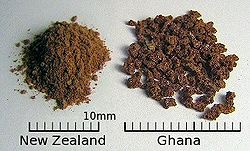 Milo differs among regions, as is seen in this side-by-side comparison of Milo from New Zealand and Ghana.
Milo differs among regions, as is seen in this side-by-side comparison of Milo from New Zealand and Ghana.
In Peru, during the 1970s military dictatorship, Milo's powder can labels displayed promotion images of Peruvian motifs, such as photos of Peruvian towns and crops,[6] or zoology and botany,[7] as an educational aid. After 1980, when the military left power, the advertising fit to a sports image.
The Indian version is no longer in production because of intense competition from other beverages.
Nestle has now introduced a Canadian version of Milo. It is made in Canada. It dissolves rapidly like Nesquik, probably due to market expectations, but still retains the malt flavour. It is also sweeter than other varieties. This Milo as the brand has been in Eastern Canada since the late 1970's with the influx of people from previous British colonial territories such as the Caribbean and Hong Kong, and India. It was available in mostly small ethnic grocery stores, especially Caribbean food stores. It has recently been selling at larger chains to beef up their share in the ethnic market in Canada, and is now available in places like Superstore, Extra Foods and London Drugs. Some East Asian supermarkets (such as T&T Supermarket in Edmonton, Vancouver, Toronto and Calgary) will carry the version imported from China or Hong Kong.
In the United States, Nestle USA markets Milo. In 2010, canned ready to drink Milo from Malaysia could be found in Target stores as well as a variety of local grocery stores. The powdered variety can also be found in some stores.
It can also be found in the UK in some Sainsbury's and Tesco supermarkets, which import it from Kenya or Uganda. Oriental Food specialists, such as Mini Siam Oriental Foods and Hoo Hing also stock it. A similar product called Ovaltine is most popular with UK consumers.
Derivative products
Milo has been made into a chocolate bar, called the "Milo", that is manufactured by Nestle and sold in Australia.
Milo has been available for many years in a malted flavour, marketed in a burgundy can alongside the traditional green tin.
Products based on Milo are available, such as cereal, yoghurt and ice cream. In addition to the powdered form, there is a pre-mixed version of Milo that comes in cans or drink boxes.
In Australia, a new version of Milo called Milo B-Smart was released in 2008 (the original and malt Milo varieties remain); which is of a finer texture and has added B vitamins and iodine. It has a different taste from the original Milo formula and is marketed as a health food for children.[8]
In some regions, a Milo branded cereal is produced. It consists of a crunchy crescent moon-shaped flake of dark brown colour. These flakes are flavoured to match Nestlé's Milo powdered drink. The flakes also have the property of flavouring the milk.
Consumption
Milo is added to hot or cold water and/or milk to make a malted chocolate beverage. It does not dissolve readily in cold milk, and so retains the gritty texture of its raw state. Milo can be stirred into steamed milk to make a drink akin to hot chocolate or cocoa. Another possible use is making a normal cup of cold Milo and microwaving it for approximately 40–60 seconds. This gives the Milo drink a biscuity cover on top.
Milo is sometimes sprinkled on ice cream, or less commonly breakfast cereals. Milo is often the favoured beverage for the Tim Tam Slam.
Also very popular is the "Magic Milo" which involves adding Milo to a small amount of milk with sugar and whipping it to increase the amount of air in the milk, thereby doubling it in size. Then one adds small amounts of hot water and milk in layers stirring each new layer vigorously to maintain its lightness. A final layer of whipped cream is then topped with extra Milo or chocolate sprinkles. This is more of a 'warm' beverage rather than a 'hot' one and is a more popular version of hot Milo for children.
Milo manufactured outside Australia is customised for local methods of preparation. Milo with ice added is known as "Milo Peng" (alternately, "ping"), "peng" ( 冰 ) meaning ice in Cantonese and Hokkien. In Japan, Milo is marketed as a canned energy drink, available in vending machines. In Hong Kong, Milo is served in Cha chaan teng.
Milo is also a famous beverage in Indian Muslim stalls, or fondly known as Mamak stalls in Malaysia. It is also sometimes used as an alternative to jam and put in bread or also as an ingredient in Roti Canai.
In the Caribbean, Milo is a popular hot beverage analogous to tea or coffee and has been around since the colonial period. In the past Milo was available in Portugal and in Brazil. Nestle Brazil discontinued production of Milo in Brazil to focus on the much-popular domestic brands Nescau and Nesquik. The Chilean version of Milo is still in production and is identical in taste and texture to the one that was once produced in Brazil.
In Nigeria, Milo is also a very popular beverage.
Nutritional information
Milo is supposedly high in energy, because the drink has 1,760 kJ in every 100 g of the drink. It is also for this reason, marketed as the "Energy Food Drink". It is also supposed to have a low Glycemic Index (GI), that is, "33 made with whole milk, 36 made with reduced fat milk". This allows the energy in Milo to be released slowly.
The Milo website states that the drink is high in calcium, iron and the vitamins B1, B2, B6, B12. It also has Actigen-E that releases the energy stored in a person's body.
See also
- Horlicks
- Malted milk
- Ovaltine
- Ovomaltine
References
External links
- Nestlé Global: Milo
- Milo at Nestlé USA
- Nestlé Australia: Milo
- Milo's History
- Nestle Philippines: Milo or http://www.milo.com.ph
- Nestlé Malaysia: Milo Requires Adobe Flash Player
- Nestlé Malaysia: Nutrition information
Hot cocoa Abuelita • Bournvita • Cafe mocha • Carnation (brand) • Champurrado • Chocomel • Cocodirect • Cola Cao • Hot chocolate • Ibarra (chocolate) • Mayordomo • Milo • Nesquik • Ovaltine • Stephen's Gourmet • Swiss Miss • ToddyCategories:- Flashlink without a parameter
- Nestlé brands
- Hot cocoa
- Non-alcoholic beverages
- Brand name beverage products
- Australian brands
- Australian cuisine
- Jamaican cuisine
- Australian snack foods
Wikimedia Foundation. 2010.

